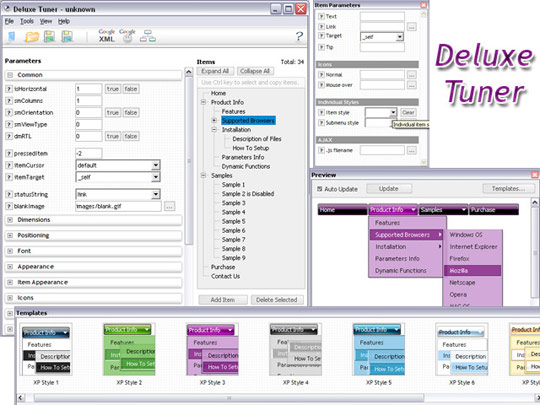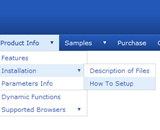Recent Questions
Q: This is probably a really basic question, but I was wondering if your software makes it possible to determine the direction of the drop down menu. In other words, my easy dropdown menu is at the bottom of the page and I want the drop down list to actually go "up," not down. Is that possible with your software?
A: Yes it is possible.
You should use the following easy dropdown menu parameter
var subMenuVAlign="top"; //downward
var subMenuVAlign="bottom"; //upward
var subMenuAlign="left"; //from left to right
var subMenuAlign="right"; //from right to left
Q: Will html navigation bar work with site created using FrontPage?
A: Yes, Deluxe CSS Menu will work fine with site created in Frontpage.
Add all code generated by Deluxe Tuner.
You should copy all css styles for the menu and add it into your own .css file (orcreate a new .css file for the menu and call it on your page).
Then copy all HTML code for the menu and paste it in the place where you want to have amenu.
To view css styles and html code click "View HTML" button on the Preview window in theDeluxe Tuner.
Q: I'm having a problem displaying a little white icon arrow on my dhtml foldout menu. I us Adobe Dreamweaver to build my site. When previewing, I found that adding . /.. to the .js file works good and it displays the arrows. But when I Put the menu on the internet it goes back to displaying a blank box like it can t find it again. My menu is in my site's root directory, and I would like to control all my site's pages with it. I am going to have a basic template for the whole site with the dhtml foldout menu on it and I am to building all the pages from that.
If I don't change the link to ../../ the only pages that will work is the one that is in the same directory as my menu files.
A: Try to use absolute paths to your images on the website. Your menu will work correctly inall cases in that case.
var pathPrefix_img="http://www.domain.org/Fundraising/Scrip/";
var arrowImageMain=["data.files/arrv_white_1.gif",""];
var arrowImageSub=["data.files/arr_white_1.gif",""];
or
var pathPrefix_img="";
var arrowImageMain=["http://www.domain.org/Fundraising/Scrip/data.files/arrv_white_1.gif",""];
var arrowImageSub=["http://www.domain.org/Fundraising/Scrip/data.files/arr_white_1.gif",""];
Q: We've used your deluxe menu on a few sites without any issues. We are trying a new site javascript menu system now and having an issue with beforeItemImage and afterItemImage. Below is our data javascript class. The dropdown seems fine in Firefox but the before and after Images are not showing up in Internet Explorer.
We've tried a number of things and can't quite get the tabbed corners in IE. Any suggestions would be greatly appreicated, we need to get this menu live soon for a client of ours. Thank you in advance.
A: Try to specify width and height parameters:
var beforeItemImageW="6";
var afterItemImageW="6";
var beforeItemImageH="19";
var afterItemImageH="19";
We've checked your page in IE6, IE7, IE8. All images displayed correctly.












